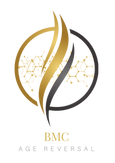THE HALLMARKS OF AGING
Aging is a disease and can be prevented
“ Ageing as a Risk Factor for Disease”
According with the WHO (World of Health Organization)
“These hallmarks are interconnected and can reinforce each other over time, leading to the progressive decline in physiological function and increased risk of age-related diseases.”
The “hallmarks of aging” refer to a set of interconnected biological processes that occur over time and contribute to the aging of living organisms.
These hallmarks are considered to be the underlying causes of aging and age-related diseases. There are currently eleven recognized hallmarks of aging:
Genomic instability
This refers to the accumulation of DNA damage over time, which can lead to mutations and cellular dysfunction.
Telomere attrition
Telomeres are the protective caps at the ends of chromosomes that shorten with each cell division. Eventually, when the telomeres become too short, cells can no longer divide and may become senescent.
Epigenetic alterations
Changes to the chemical modifications of DNA and its associated proteins can cause changes in gene expression that contribute to aging.
Loss of proteostasis
The ability of cells to properly fold and maintain proteins decreases over time, leading to a buildup of damaged proteins and cellular dysfunction.
Deregulated nutrient sensing
Changes in nutrient sensing pathways can disrupt cellular metabolism and contribute to age-related diseases such as obesity, diabetes, and cancer.
Mitochondrial dysfunction
Mitochondria are the energy-producing organelles within cells, and as they age, they become less efficient and produce more damaging byproducts.
Cellular senescence
Some cells become senescent, meaning they stop dividing but do not die, leading to a buildup of non-functional cells that can contribute to age-related diseases.
Stem cell exhaustion
Stem cells are responsible for repairing and regenerating tissues, but they become depleted over time, leading to a decline in tissue function.
Altered intercellular communication
Changes in the signalling between cells can disrupt the normal functioning of tissues and organs, contributing to aging and age related diseases.
Chronic Inflammation
Refers to your body’s process of fighting against things that harm it, like infections, injuries, and toxins, in an attempt to heal itself.
Intestinal Dysbiosis
Our body is full of colonies of harmless bacteria known as microbiota. Most of these bacteria have a positive effect on your health and contribute to your body’s natural processes. But when one of these bacterial colonies is out of balance, it can lead to dysbiosis.
These hallmarks are interconnected and can reinforce each other over time, leading to the progressive decline in physiological function and increased risk of age-related diseases.
